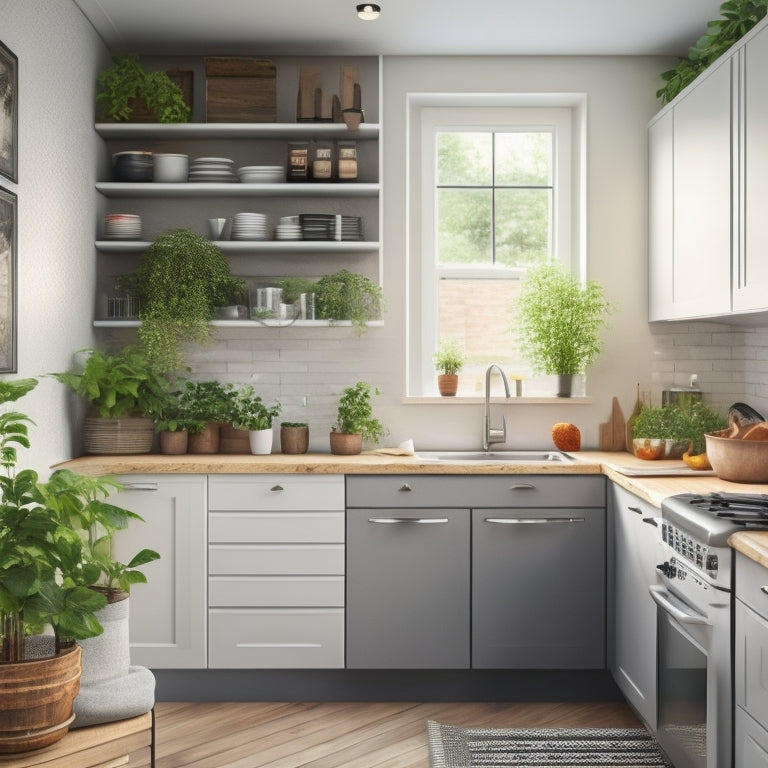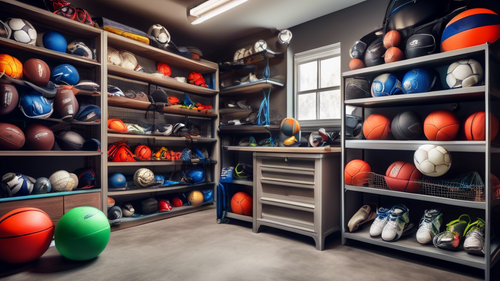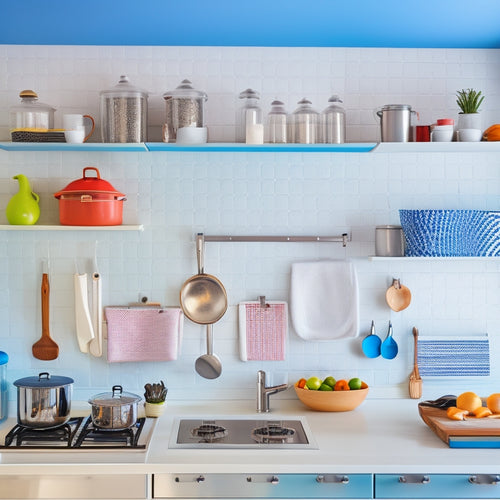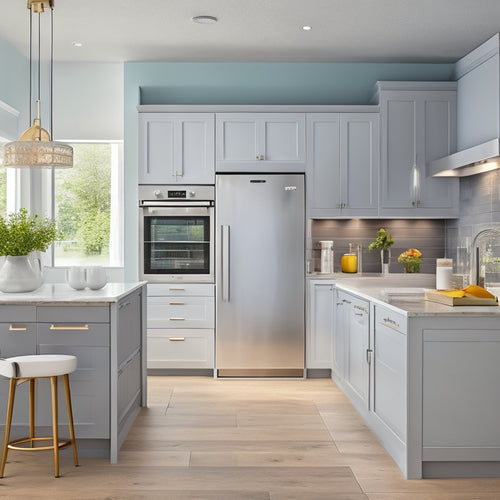
10 Tips for Decluttering Small Kitchens
Share
You're on a mission to declutter your small kitchen and maximize every inch of available space. Start by evaluating your kitchen's storage needs, then purge unnecessary items and optimize your cabinet organization systems. Employ vertical storage spaces, choose multifunctional kitchen tools, and implement a "one in, one out" policy. Consider a cart or island solution, label and sign everything clearly, and maintain your newly decluttered space. By following these 10 tips, you'll be well on your way to creating a more efficient, organized kitchen that makes meal prep a breeze - and there's even more to uncover to take your kitchen to the next level.
Key Takeaways
- Assess kitchen storage needs by identifying daily-use items, measuring cabinets and shelves, and creating a customized storage plan.
- Purge unnecessary items by gathering boxes for donations, recyclables, and trash, and adopting a one-in, one-out policy.
- Optimize cabinet organization systems with drawer organizers, clear bins, and pull-out shelves to maximize storage and accessibility.
- Utilize vertical storage spaces with shelves, hooks, and pegboards to make the most of wall space and keep countertops clear.
- Implement a "junk drawer" with dividers, categorization, and adhesive magnets to maintain order and reduce clutter.
Assess Your Kitchen's Storage Needs
Your kitchen's storage space is a significant asset, and understanding its needs is essential to effective decluttering. Take stock of your kitchen essentials and identify what you need to store.
Consider the items you use daily, such as pots, pans, utensils, and dishes. Think about the storage solutions that will keep these items organized and within reach.
Don't forget to adopt a one in, one out policy streamlining digital life to prevent new clutter accumulation in your kitchen. Measure your cabinets, shelves, and countertops to determine the ideal storage layout.
This assessment will help you prioritize your storage needs and create a functional space that works for you. By understanding your kitchen's unique requirements, you'll be able to create a customized storage plan that maximizes your space and minimizes clutter.
Purge Unnecessary Items First
The kitchen purge begins. You're ready to tackle the clutter, and it's time to get ruthless.
Start by gathering boxes or bags for donations, recyclables, and trash. Go through every cabinet, drawer, and countertop, pulling out items you no longer use, need, or love.
Be honest with yourself – when was the last time you used that appliance or gadget? Donate unused items that are still in good condition to a local charity or sell them online.
Recycle packaging materials like cardboard, plastic, and glass. Be mindful of items that can't be donated or recycled, like broken appliances or expired food.
Get rid of them responsibly. By purging unnecessary items, you'll create space for what's truly essential in your kitchen.
Optimize Cabinet Organization Systems
With cabinets cleared of clutter, it's time to maximize their storage potential. You've got a clean slate to design an organization system that works for you.
-
Install drawer organizers and cabinet liners to keep items from shifting around and making a mess.
-
Use storage containers and clear bins to store dry goods and snacks, making it easy to see what you have.
-
Add pull-out shelves, lazy susans, and tiered racks to make the most of corner spaces and hard-to-reach areas.
-
Designate a spice rack and specific zones for food storage to keep your kitchen running smoothly.
-
Don't forget under sink solutions to keep cleaning supplies and trash bags tidy.
Utilize Vertical Storage Spaces
You can't afford to waste a single inch of space in a small kitchen, so it's important to maximize your wall space by installing shelves, hooks, or a pegboard.
This will help keep frequently used items within easy reach while keeping countertops clear. By adding shelf dividers, you can further optimize your vertical storage spaces and keep similar items organized and easy to access.
Maximize Wall Space
Hang pots, pans, and utensils from ceiling-mounted racks or hooks to capitalize on the often-wasted vertical space above your countertops. This will help keep them organized, easily accessible, and free up precious cabinet space.
To maximize your wall space, consider the following:
- Install wall-mounted racks for spices, oils, or frequently used ingredients to keep them within easy reach.
- Use decorative shelves to display cookbooks, decorative items, or infrequently used kitchen gadgets.
- Mount a pegboard on a wall or the back of a door to hang utensils, baskets, or other items.
- Add a wall-mounted pot lid holder to keep lids organized and easy to find.
- Install a wall-mounted knife block to keep your countertops clear and your knives organized.
Install Shelf Dividers
Shelf dividers are a revolutionary innovation for small kitchens, allowing you to employ vertical storage spaces and keep similar items organized and easily accessible.
By installing shelf dividers, you can separate items on a shelf, making it easier to find what you need. Choose shelf dividers made from durable materials like wood, metal, or plastic that fit your kitchen's style.
There are various divider types to examine, including adjustable, fixed, and stackable options. Adjustable dividers are ideal for shelves with varying item sizes, while fixed dividers are better for storing uniform items. Stackable dividers are perfect for maximizing vertical storage.
With shelf dividers, you'll be able to create a more organized and efficient kitchen space.
Choose Multifunctional Kitchen Tools
By opting for multifunctional kitchen tools, you'll not only reduce clutter but also streamline your cooking process. This is especially important in small kitchens where every inch counts.
Multitasking utensils and space-saving gadgets can help you achieve a more organized and efficient kitchen.
Some examples of multifunctional kitchen tools include:
- A garlic press that doubles as a citrus juicer
- A silicone spatula with a built-in bottle opener
- A collapsible measuring cup that takes up minimal storage space
- A knife block with built-in sharpening steel
- A stand mixer with interchangeable attachments for various tasks
Designate a "Junk Drawer"
You're likely guilty of having a drawer in your kitchen that's become a catch-all for miscellaneous items, from takeout menus to twist ties.
This so-called "junk drawer" can be overwhelming, but it's important to designate a space for items that don't have a designated home.
Identify your junk drawer essentials, such as batteries, candles, and spare change, and organize them using dividers or small containers.
Implementing organizing strategies, like categorizing items into groups or using adhesive magnets, will help maintain order.
By designating a specific space for these items, you'll reduce clutter and make your kitchen feel more streamlined.
Implement a "One In, One Out" Policy
The never-ending battle against kitchen clutter requires a proactive approach, and implementing a "one in, one out" policy is a simple yet effective way to maintain a balanced amount of possessions.
By adopting this rule, you'll guarantee that for every new item you bring into your kitchen, an old one must be removed. This will help you stay mindful of your purchases and prevent clutter from building up again.
- Before buying a new kitchen gadget, identify an old one to donate or discard.
- Consider donation options for gently used items that are still in good condition.
- Be honest with yourself about which items you truly need and use regularly.
- Don't be too hard on yourself if you struggle to let go of certain items - decluttering challenges are normal.
- Remember, the goal is to maintain a balanced amount of possessions, not to deprive yourself of things you need.
Consider a Cart or Island Solution
Kitchen carts and islands can be a revolutionary addition for small kitchens, providing essential counter space and storage without sacrificing floor space.
You'll appreciate the kitchen cart benefits, such as extra storage for utensils, spices, and cookbooks, keeping them organized and within reach.
Islands, on the other hand, offer island functionality like built-in sinks, cooktops, or wine racks, increasing your kitchen's functionality.
When choosing a cart or island, consider your specific needs and the layout of your kitchen. Measure the space carefully to guarantee a comfortable fit.
With a cart or island, you'll be able to prep, cook, and entertain with ease, all while maintaining a clutter-free kitchen.
Label and Sign Everything Clearly
You'll be surprised at how much more efficient your small kitchen becomes when everything has its designated spot and is clearly labeled.
By labeling essentials like spices, oils, and snacks, you'll save time searching for what you need and reduce clutter.
Create an organization station by signing areas like a utensil holder or a coffee station to keep similar items together.
Labeling Essentials
Across every inch of your compact kitchen, clutter can quickly accumulate, making it difficult to find what you need when you need it.
To take control, you need a labeling system that helps you identify what's inside your clear containers. This way, you can quickly locate the item you need, saving you time and frustration.
- Use labels that are easy to read and understand
- Label everything, including spices, oils, and cleaning supplies
- Designate a specific area for frequently used items
- Consider color-coding labels to categorize items
- Keep labels consistent throughout your kitchen to create a sense of harmony
Organization Station
Now that you've labeled all your containers, it's time to take it to the next level by creating an organization station that makes sense of everything.
This station will help you maximize your kitchen layout and optimize your storage solutions. Designate a specific area, such as a countertop or shelf, as your organization hub.
Use a pegboard or hooks to hang frequently used items like utensils, spices, or oils. Install a small shelf or basket to store recipe books, kitchen gadgets, or snacks.
Consider a turntable or lazy Susan to access items easily. By creating an organization station, you'll have everything you need within reach, making meal prep and cooking more efficient.
Maintain Your Newly Decluttered Space
With your small kitchen decluttered and organized, the real challenge begins: keeping it that way.
You've worked hard to create a space that sparks joy, and now it's time to uphold that feeling.
To keep your kitchen clutter-free, commit to:
-
Regular cleaning: Set aside time each week to wipe down surfaces, sweep, and mop.
-
Seasonal reevaluation: Schedule a deeper clean and reorganization every 3-4 months to guarantee your space still meets your needs.
-
Designating a "launching pad" for daily clutter, like a tray or basket near the entrance.
-
Implementing the "one in, one out" rule to prevent new clutter from accumulating.
-
Scheduling regular "maintenance days" to tackle tasks like cleaning the oven or refrigerator.
Frequently Asked Questions
How Do I Declutter Sentimental Kitchen Items From Family Members?
When decluttering sentimental kitchen items from family members, you're not just clearing space, you're managing emotional attachment. Start by acknowledging the memories attached to family heirlooms, then ask yourself if keeping them truly honors those memories or holds you back.
What if I Have Limited Budget for New Storage Solutions?
You're working with a shoestring budget, and fancy storage systems are out of the question. Fear not! You'll find budget-friendly solutions by getting creative with DIY storage ideas, repurposing items you already own, and maximizing your kitchen's hidden spaces.
Can I Declutter My Kitchen if I'm Not a Minimalist?
You don't have to be a minimalist to declutter your kitchen; start by identifying what you use daily and what's taking up unnecessary space, then focus on kitchen organization and clutter reduction strategies that work for you.
How Often Should I Maintain My Newly Decluttered Kitchen Space?
Will you let clutter creep back in, or will you conquer it? Set a maintenance schedule to stay on top of your decluttering routine, dedicating 10-15 minutes daily to uphold your newly organized kitchen space.
What if I Have a Non-Traditional Kitchen Layout or Shape?
You're working with a non-traditional kitchen layout or shape, so think outside the box! You'll need creative storage solutions and unique organization ideas that cater to your space's quirks, maximizing every nook and cranny to create a functional, clutter-free zone.
Related Posts
-

Sports Equipment Organization for the Garage
Sports Equipment Organization for the Garage: A Comprehensive Guide As an avid sports enthusiast, I know firsthand...
-

10 Essential Tips to Organize Your Compact Kitchen
You're about to change your compact kitchen into a highly functional and organized space that makes meal prep a breez...
-

Space-Saving Kitchen Design Ideas
You can change your cramped kitchen into a sleek, efficient space where every inch counts. Start by optimizing your w...


